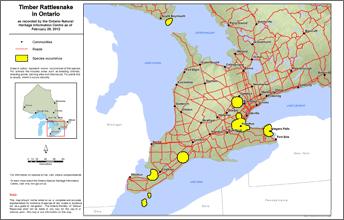Timber rattlesnake
Scientific name: Crotalus horridus

Cover photo credit: J.D. Taylor
Status
Extirpated
“Extirpated” means the species lives somewhere in the world, and at one time lived in the wild in Ontario, but no longer lives in the wild in Ontario.
Date added to the Species at Risk in Ontario List
The Timber rattlesnake was already listed as extirpated when the Endangered Species Act took effect in 2008.
Read the assessment report.
What it looks like
The Timber rattlesnake is a greyish-brown to yellow, thick-bodied snake with a triangular-shaped head and dark markings that start as blotches on the front of the body but are fused together to form crossbands (chevron-shaped markings) along most of the body and the tail. The colouration at the tip of the tail becomes noticeably dark. It can grow to almost two metres long.
Where it lives
The Timber rattlesnake was consciously eradicated from Ontario by people. In the nineteenth century, hunting parties would attack den sites and kill all the snakes that could be found.
Where it’s been found in Ontario
This rattlesnake was found along the Niagara Escarpment, primarily in the Niagara area. The most recent confirmed records of this rattlesnake in Ontario are from the Niagara Gorge in the 1940s.
This species occurs throughout the eastern and central United States, although it is locally extirpated in many areas.
View a Larger version of this map (PDF)
Why it disappeared from Ontario
The Timber rattlesnake was consciously eradicated from Ontario by people. In the nineteenth century, hunting parties would attack den sites and kill all the snakes that could be found.
Action we are taking
Extirpated species and their habitat are protected if the species are again found in Ontario.
Help Make Sure We Don’t Lose More Endangered Species in Ontario
- the Ministry of Natural Resources and Forestry tracks species at risk such as the Timber rattlesnake; report a sighting of an endangered animal or plant to the Natural Heritage Information Centre. Photographs with specific locations or mapping coordinates are always helpful.
- try to develop an appreciation for snakes; they play an important role in our environment; whether in a field or in your backyard, if you come across a snake, keep in mind that you are much larger than it is and the snake is more afraid of you than you are of it
- if you come across a snake, please don’t try to capture it, handle it or kill it; snakes can be delicate and improper handling can cause serious injury; also, certain species are protected under legislation, which makes it illegal to harass, harm or kill them; be respectful and observe from a distance
- watch for snakes that may be crossing roads between May and October; road mortality is a serious threat to snakes because they are slow moving, hard to see on the road and are sometimes intentionally run over; if it is safe to do so, help snakes across the road in the direction they were headed
- private land owners have an important role to play in species recovery; you may be eligible for stewardship programs that support the protection and recovery of species at risk and their habitats
- report poaching of snakes and other animals to
1-877-TIP-SMNR (847-7667) - volunteer with a local nature club or provincial park to participate in surveys or stewardship work focused on species at risk
- visit the Ontario Reptile and Amphibian Atlas or Toronto Zoo Adopt-a-Pond website to learn more about Ontario’s rare snakes, their habitat and related conservation initiatives
Quick facts
- this rattlesnake is a sit and wait predator; it frequently coils up adjacent to a small mammal scent trail and may wait for several days for the unsuspecting small mammal
- individuals return to the same hibernation site year after year
- although the Timber rattlesnake is venomous, there are few records of human fatalities; More people die every year from insect stings than rattlesnake bites
